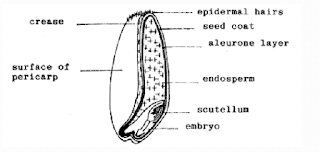Introduction to sugar technology
Sugar refers to the monosaccharides and disaccharide form of carbohydrates. However commercially sugar almost always refers to sucrose. There are three Main sources of sugar
a. SUGAR CANE
b. SUGAR BEET
c. HONEY.
Other sources include
d. The corn syrup
e. The maple syrup.
1.1.1 SUGAR CANE
This is a tall perennial grass with tillers at the base and a branched stem. There three main varieties of sugar cane:
The botanical name for sugarcane is Saccharium officinarium
This has been known for over 12000 years. Its origin is New Guinea where it landed in the hands of Christopher Columbus.
VARIETIES OF SUGAR CANES
a. Wild/original variety which has thin stems, a lot of trash/ leaves and not self -cleaning. It has low sugar content.
b. Noble variety which is self -cleaning and has high sugar content, thick stem and low fibre content.
c. Hybrid variety which has intermediate properties.
1.1.2. The sugar beet
Production of sugar from the sugar beet started in the 19th century. It originally contained about 4-5% sucrose but this has been improved through breeding to about 20%.
Differences between sugar beets and sugar canes
1. Sugarcane is grown in tropics where temperatures are high while sugar beet is grown in low temperature regions.
2. Sugar cane requires more water than the sugar beet.
3. Cane is more labor intensive than sugar beet.
4. Sugar beet with only some few selective breeding has produced a variety with high sugar content compared with sugar cane.
5. The sucrose content of sugarcane can change if it is left in the field for more than two days. This is not the case with sugar beet.
6. The equipment used in processing of sugar from sugarcane is heavy and expensive
1.2. Manufacture of sugar from sugar beet
Sugar beet is a root crop that grows in the temperate regions. It has a sugar content of about 20%.
The following steps are followed in production of sugar from the sugar beet.
1. Reception, grading and cleaning once the beets are received in the plant they are cleaned to remove the physical dirt.
2. Size reduction: the beets are cut into stripes or slices known as cossets.
3. Diffusion/extraction ; the cossets are fed into a diffuser, and sprayed with hot water at 700C. the movement of the cossets and the water is counter current.
Note; the temperature of the extracting water should not exceed 700C as higher temperatures which lead to extraction of colored pigments from the cossets. The residue of the cossets is used as animal feed.
4. Concentration
5. Evaporation
6. Crystallization
7. Centrifugation
8. Drying and
9. Packaging.



Comments
Post a Comment